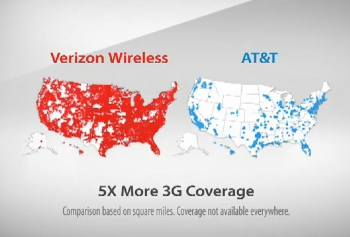AT&T Sues Verizon Over 'There's a Map for That' Ads
AT&T has taken offense at the recent Verizon 'There's a Map for That' ad campaign and has filed a lawsuit against Verizon. AT&T claims that the ads are "misleading" customers and resulting in the loss of "incalculable market share." The lawsuit may backfire though as AT&T draws more attention to the ad campaign and the shortcomings of its own 3G network.

AT&T doesn't claim that the information related to 3G coverage is wrong, but rather that customers that view the ads are too dumb to understand that it is only referring to 3G coverage, and not coverage in general.
The claim itself is just silly. Imagine if Ford made a commercial comparing the Ford Mustang to the Chevy Camaro and it used a blue Mustang and a white Camaro in the ad. The AT&T lawsuit against Verizon is like Chevy suing Ford and claiming that the ad misleads customers into believing that the Camaro is only available in the color white and its hurting the sales of the other colors the Camaro is available in. People aren't really that dumb.
The lawsuit was a bad strategic move for AT&T because it has the exact opposite effect of its goal. AT&T has asked for an injunction to prevent Verizon from continuing the ad campaign so that customers won't continue to see the stark contrast of the 3G networks from each provider. The result is that the marketing campaign is getting tons of attention and free advertising, and customers are led to question what AT&T is trying to hide.
What AT&T needs to realize is that it's a smart phone world. Mobile phones are not just phones any more--they're being replaced by mobile computing devices. Yes, AT&T has coverage of some sort in the vast majority of the blank white space depicted on the map in the Verizon ad, but that coverage is not sufficient to meet the needs of devices that rely on broadband connectivity.
AT&T marketing claims that it has the 'fastest 3G network'. For customers who live within the city limits of major urban centers that may be great, but for the people living in the white part of the map in the Verizon ad having the biggest 3G network is a more relevant claim. In an industry that is already moving on to 4G networks, not having 3G coverage is the same as no coverage for all intents and purposes.
I am an AT&T customer. I have been for years. I have no issues with my service per se, and I have no intention of switching providers any time soon. However, having driven cross-country trying to use my mobile phone as an Internet connection for my laptop I can vouch for the fact that there were far more areas where I couldn't get a 3G connection than areas where I could.
AT&T's grasping-at-straws lawsuit has a sort of "thou doth protest too much" air of desperation to it. AT&T has only 20 percent of the 3G coverage Verizon has and it is more or less married to the iPhone for the foreseeable future. Meanwhile Verizon is starting to roll out 4G connectivity and is stirring excitement with the Motorola Droid.
AT&T does need a new strategy, but I don't think its going to capture any market share by burying its head in the sand and trying to pretend its network is more capable than it really is.
Tony Bradley is an information security and unified communications expert with more than a decade of enterprise IT experience. He tweets as @PCSecurityNews and provides tips, advice and reviews on information security and unified communications technologies on his site at tonybradley.com .













Add Your Comment